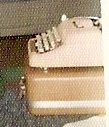
I’ve been trying to acquire a Smith-Corona Silent-Super portable typewriter in the bright pink with white keys for years. See, my mom owned that model of typewriter since her teen years, so I grew up with that typewriter in the house. And at the age of ten, when Mom decided that she was not going to be typing up any papers for me when I got to that stage in school, she sat me down with her old typing text book and started teaching me to type. I achieved a typing speed of a bit over 60-words a minute on that machine by the time I was in middle school, and being able to hit such speed on a mechanical typewriter is why my computer typing speed is about 105 words per minute.
And the Silent-Super was a dream. It was regarded by many as one of the best typewriters ever made. Mom’s was in great shape, with a touch so light and well-balanced, you felt almost as if you could have typed just by blowing on the keys.
Smith-Corona made the Silent-Super, and similar models such as the Silent Standard and Silent Writer, in a variety of colors. The most common, going by how many you can find for sale on line decades later were seafoam green and sterling blue. There was also grey, black, peach, flamngo pink, tan, chrome, and apparently a small run of gold-plated ones. The flamingo pink was a much darker pink that the Easter, and the highlight stripes, Smith-Corona logo, and other writing embossed on the colored parts of the case is red. The peach is a slightly orange-y pink, with the stripes, logo, and other words in a tan color.
 I typed a lot of stories on Mom’s Silent-Super. Then my paternal grandmother gave me her old ’52 Remington Letter-Riter, which was a much heavier (and therefore sturdier) machine. The Letter-Riter was the machine on which I wrote the first story that I sold professionally, and I kept using the Remington as my primary writing instrument until 1986, when I finally started using Word Processors.
I typed a lot of stories on Mom’s Silent-Super. Then my paternal grandmother gave me her old ’52 Remington Letter-Riter, which was a much heavier (and therefore sturdier) machine. The Letter-Riter was the machine on which I wrote the first story that I sold professionally, and I kept using the Remington as my primary writing instrument until 1986, when I finally started using Word Processors.
I was always envious of Mom’s Silent-Super, and sometimes just enjoyed looking at it when I visited. Mom’s typewriter, unfortunately, fell prey to her second husband’s substance abuse problems. Several things she owned mysteriously vanished over a period of time, and when he went into rehab (after she had started divorce proceedings), he admitted that he had pawned or otherwise sold most of those items.
Since I collect manual typewriters, I’ve always wanted to add an Easter pink Silent-Super to my hoard. Because far fewer Easter pink models were produced than the other colors, and because the Silent-Super is so light and easy to type on compared to many others, usually when I do find a working model on line, it’s way more expensive than I ought to pay for a nostalgic hobby piece (example: the last one I bid on on ebay, I dropped out of the bidding at $300; the winning bid was more than twice that).

When it arrived it took a bit to unpack. The folks who sent it certainly do know how to pack it so that none of the moving parts will move during shipping. I took some pictures, then called Mom to tell her that I’d finally gotten my big present. She asked what it was, and I said “Here’s a clue,” and started typing. She was very puzzled as to why Michael had gotten me a typewriter. Somehow, she had forgotten times before when I’ve told her about my collection. I sent the pictures, but for some reason they weren’t arriving, so I told her.


A couple of the type heads don’t lay flat as they ought. It doesn’t seem to affect the typing, so I don’t think I’m going to mess with them. The uneven keys should be fixable just by bending, though you want to do it in a way that doesn’t bend other parts of the mechanism attached to each key. So I’ve acquired small needle-nosed vice grips and some other tools, and will work on the keys.
Saturday night I did some more cleaning, added some more light machine oil to three keys on the far right that were still a little stiff. Typing those keys repeatedly after adding the extra oil helped.
And while I was at it, I got out the rest of my typewriter collection. I spent most of the evening cleaning my old 1952 Remington-Rand Letter-Riter. It’s the one I’ve owned since I was a teen-ager, and before that was owned by my grandmother. It is the one in the most precarious shape, as many parts broke on it, and 17-year-old me did most of the repairs myself, with materials I had on hand and no budget.
There will probably be more posts on the topic of the other typewriters.
The latch on the case barely worked. Michael took it apart, figured out what was wrong, and put it back together. It is still a little tricky, but I can actually reliably latch it, now.
It’s been a long time since I hosted or arranged a round-robin event. I may have to do that sometime soon, now that I own five typewriters.
Regardless, I am now almost certainly going to do at least one day of NaNoWriMo on one of the typewriters. Just for fun.
1 thought on “Tap, tap, tappity-tap-tap-tappity-tap!”